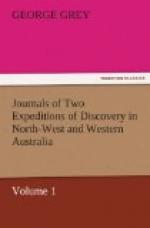Two other instances of Australian caves which contain paintings have been recorded. The first is by Captain Flinders and the second by Mr. Cunningham in King’s voyage.
PAINTINGS AT CHASM ISLAND.
The caves found by Flinders were in Chasm Island,
in the Gulf of
Carpentaria, and are thus described:*
In the steep sides of the chasms were deep holes or caverns undermining the cliffs; upon the walls of which I found rude drawings, made with charcoal, and something like red paint, upon the white ground of the rock. These drawings represented porpoises, turtles, kangaroos, and a human hand; and Mr. Westall, who went afterwards to see them, found the representation of a kangaroo, with a file of thirty-two persons following after it. The third person of the band was twice the height of the others, and held in his hand something resembling the waddy or wooden sword of the natives of Port Jackson.
(Footnote. Flinders’ Voyages volume 2 page 158.)
...
PAINTINGS AT CLACK’S ISLAND.*
(Footnote. North-east coast of Australia.)
The second instance is taken from Mr. Cunningham’s manuscripts and is contained in the following extract:*
The south and south-eastern extremes of Clack’s Island presented a steep, rocky bluff, thinly covered with small trees. I ascended the steep head, which rose to an elevation of a hundred and eighty feet above the sea.
The remarkable structure of the geological features of this islet led me to examine the south-east part, which was the most exposed to the weather, and where the disposition of the strata was of course more plainly developed. The base is a coarse, granular, siliceous sandstone, in which large pebbles of quartz and jasper are imbedded: this stratum continues for sixteen to twenty feet above the water: for the next ten feet there is a horizontal stratum of black schistose rock which was of so soft a consistence that the weather had excavated several tiers of galleries; upon the roof and sides of which some curious drawings were observed, which deserve to be particularly described. They were executed on a ground of red ochre (rubbed on the black schistus) and were delineated by dots of a white argillaceous earth, which had been worked up into a paste. They represented tolerable figures of sharks, porpoises, turtles, lizards (of which I saw several small ones among the rocks) trepang, starfish, clubs, canoes, water gourds, and some quadrupeds, which were probably intended to represent kangaroos and dogs. The figures, besides being outlined by the dots, were decorated all over with the same pigment in dotted transverse belts. Tracing a gallery round to windward, it brought me to a commodious cave or recess, overhung by a portion of the schistus, sufficiently large to shelter twenty natives whose recent fire places appeared on the projecting area of the cave.
Many turtles’ heads were placed on the shelves or niches of the excavation, amply demonstrative of the luxurious and profuse mode of life these outcasts of society had, at a period rather recently, followed. The roof and sides of this snug retreat were also entirely covered with the uncouth figures I have already described.




